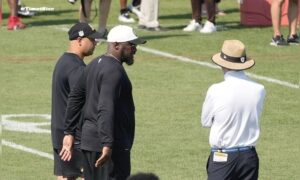Back in the early stages of the offseason, after former Pittsburgh Steelers running back Jonathan Dwyer chose to sign with the Arizona Cardinals instead of re-signing with the Steelers, the front office began turning their focus to other options.
One of those options turned out to be LeGarrette Blount, who came in for a visit but had not yet signed, and I wrote during that period that it was time for the Steelers to make a move as their options for a veteran change of pace back were getting pulled off the market.
Naturally, Blount was a player with plenty of off the field flags, going back even to his college days, where he was suspended for punching an opposing player. He went undrafted because of these concerns, but his talent ultimately won the day—for a while.
The Tampa Bay Buccaneers hung on to him for as long as they could, even though they needed to babysit him and make sure he woke up and got to the stadium on time for meetings. When Doug Martin made him expendable, the New England Patriots took a flyer on him.
The structure within that organization and the fact that he had to scratch and claw his way to the top of the depth chart seemed to keep him in tow for a while, but there’s a reason the Patriots didn’t make much effort to keep him on board. And no, that reason wasn’t Jonas Gray.
Despite averaging five yards per carry and rushing for 166 yards and four touchdowns in a playoff game for the Patriots, Blount found himself available to the Steelers, and Mike Tomlin was happy to welcome him to the fold, allegedly selling him on the idea that he felt the Steelers could do with himself and Le’Veon Bell what many teams had to do with three.
So it was that talent won the day once again for six foot, 250 pound back, who was to play second fiddle to Bell in the Steelers’ backfield. But outside of a single game against the Carolina Panthers in which he accounted for 118 of his 266 rushing yards on the season, his on-field product was far from what was expected.
In the 10 games in which he carried the ball, Blount averaged four yards per carry or more in only two games, averaging less than three yards in six of the remaining eight.
The Steelers believed that he could be a change of pace back, but they also believed he could be used situationally in short yardage and at the goal line. These beliefs were generally unfounded.
Blount was given the ball 16 times in situations in which a first down or touchdown was three yards away or less. He converted only 10 of those opportunities, with one touchdown. 10 of those carries came on third or fourth down, on which he converted six. The average distance to go was 1.5, while he averaged 1.4 yards on those plays for a total of 14 yards.
In goal to go situations, he carried six times for six total yards. That included a touchdown run of eight yards, as well as a loss of eight yards from the one-yard line. His other touchdown came on third and one from seven yards out. In all, he carried inside the red zone 11 times for 25 yards at 2.27 yards per attempt, including a fumble.







